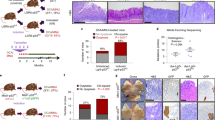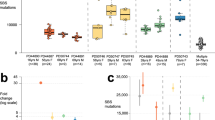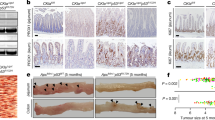Abstract
Msh2 deficiency and food-borne carcinogen PhIP have been implicated as genetic and environmental factors, respectively, in human colon carcinogenesis. It is not clear whether loss of one or both alleles of Msh2 gene increases the mutational sensitivity in colon when exposed to environmental carcinogens. In the current study, Msh2+/−/lacI and Msh2−/−/lacI double transgenic mice were treated with PhIP and mutations in the lacI gene were studied in the colon. The spontaneous mutation frequency (MF) is approximately eightfold higher in Msh2−/− mice than in Msh2+/+ mice, while Msh2+/− mice display similar levels of spontaneous mutation as the Msh2 wild type mice. PhIP induced a significant increase in MF in all genotypes of mice. However, induced MF is much higher in Msh2−/− mice compared to Msh2+/+ and Msh2+/− mice. Msh2+/− mice displayed an increased level of G:C>T:A transversions and −1 frameshifts upon PhIP treatment. In contrast, loss of both Msh2 alleles mainly results in increased frequency of G:C>A:T transitions when exposed to PhIP. These results suggest that a defect in mismatch repair may result in an enhanced sensitivity from exposure to a dietary carcinogen. It also provides insight into interaction between genetic and environmental factors in human carcinogenesis.
This is a preview of subscription content, access via your institution
Access options
Subscribe to this journal
Receive 50 print issues and online access
$259.00 per year
only $5.18 per issue
Buy this article
- Purchase on Springer Link
- Instant access to full article PDF
Prices may be subject to local taxes which are calculated during checkout


Similar content being viewed by others
References
Acharya S, Wilson T, Gradia S, Kane MF, Guerrette S, Marsischky GT, Kolodner R, Fishel R . 1996 Proc. Natl. Acad. Sci. USA 93: 13629–13634
Andrew SE, McKinnon M, Cheng BS, Francis A, Penney J, Reitmair AH, Mak TW, Jirik FR . 1998 Proc. Natl. Acad. Sci. USA 95: 1126–1130
Andrew SE, Pownall S, Fox J, Hsiao L, Hambleton J, Penney JE, Kohler SW, Jirik FR . 1996 Mutat. Res. 357: 57–66
Boring CC, Squires TS, Tong T, Montgomery S . 1994 CA Cancer J. Clin. 44: 7–26
Bronner CE, Baker SM, Morrison PT, Warren G, Smith LG, Lescoe MK, Kane M, Earabino C, Lipford J, Lindblom A . 1994 Nature 368: 258–261
Cariello NF, Gorelick NJ . 1996 Environ. Mol. Mutagen. 28: 397–404
Carothers AM, Yuan W, Hingerty BE, Broyde S, Grunberger D, Snyderwine EG . 1994 Chem. Res. Toxicol. 7: 209–218
de Boer JG, Glickman BW . 1998 Genetics 148: 1441–1451
Dohet C, Wagner R, Radman M . 1986 Proc. Natl. Acad. Sci. USA 83: 3395–3397
Dycaico MJ, Provost GS, Kretz PL, Ransom SL, Moores JC, Short JM . 1994 Mutat. Res. 307: 461–478
Endo H, Schut HA, Snyderwine EG . 1994 Cancer Res. 54: 3745–3751
Erfle HL, Walsh DF, Holcroft J, Hague N, de Boer JG, Glickman BW . 1996 Environ. Mol. Mutagen. 28: 393–396
Eshleman JR, Markowitz SD . 1996 Hum. Mol. Genet. 5: 1489–1494
Fearon ER, Vogelstein B . 1990 Cell 61: 759–767
Felton JS, Knize MG, Shen NH, Lewis PR, Andresen BD, Happe J, Hatch FT . 1986 Carcinogenesis 7: 1081–1086
Felton JS, Malfatti MA, Knize MG, Salmon CP, Hopmans EC, Wu RW . 1997 Mutat. Res. 376: 37–41
Fishel R, Lescoe MK, Rao MR, Copeland NG, Jenkins NA, Garber J, Kane M, Kolodner R . 1994 Cell 77: 167
Fishel R, Wilson T . 1997 Curr. Opin. Genet. Dev. 7: 105–113
Fornasarig M, Viel A, Valentini M, Capozzi E, Sigon R, De Paoli A, Della PL, Boiocchi M . 2000 Oncol. Rep. 7: 39–43
Frandsen H, Grivas S, Andersson R, Dragsted L, Larsen JC . 1992 Carcinogenesis 13: 629–635
Genschel J, Littman SJ, Drummond JT, Modrich P . 1998 J. Biol. Chem. 273: 19895–19901
Glaab WE, Kort KL, Skopek TR . 2000 Cancer Res. 60: 4921–4925
Glaab WE, Skopek TR . 1999 Carcinogenesis 20: 391–394
Godard V, Coulet F, Bernaudin JF, Housset M, Soubrier F . 1999 Ann. Dermatol. Venereol. 126: 600–603
Gooderham NJ, Murray S, Lynch AM, Yadollahi-Farsani M, Zhao K, Rich K, Boobis AR, Davies DS . 1997 Mutat. Res. 376: 53–60
Ito N, Hasegawa R, Sano M, Tamano S, Esumi H, Takayama S, Sugimura T . 1991 Carcinogenesis 12: 1503–1506
Kolodner RD, Marsischky GT . 1999 Curr. Opin. Genet. Dev. 9: 89–96
Leach FS, Nicolaides NC, Papadopoulos N, Liu B, Jen J, Parsons R, Peltomaki P, Sistonen P, Aaltonen LA, Nystrom-Lahti M . 1993 Cell 75: 1215–1225
Loeb LA . 1991 Cancer Res. 51: 3075–3079
Lynch HT, Schuelke GS, Kimberling WJ, Albano WA, Lynch JF, Biscone KA, Lipkin ML, Deschner EE, Mikol YB, Sandberg AA . 1985 Cancer 56: 939–951
Marra G, Boland CR . 1996 Gastroenterol. Clin. North Am. 25: 755–772
Marsischky GT, Filosi N, Kane MF, Kolodner R . 1996 Genes Dev. 10: 407–420
Modrich P . 1991 Annu. Rev. Genet. 25: 229–253
Modrich P . 1997 J. Biol. Chem. 272: 24727–24730
Okonogi H, Stuart GR, Okochi E, Ushijima T, Sugimura T, Glickman BW, Nagao M . 1997a Mutat. Res. 395: 93–99
Okonogi H, Ushijima T, Zhang XB, Heddle JA, Suzuki T, Sofuni T, Felton JS, Tucker JD, Sugimura T, Nagao M . 1997b Carcinogenesis 18: 745–748
Planck M, Wenngren E, Borg A, Olsson H, Nilbert M . 2000 Genes Chromosomes Cancer 29: 33–39
Radman M, Dohet C, Jones M, Doutriaux MP, Laengle-Rouault F, Maenhaut-Michel G, Wagner R . 1985 Biochimie 67: 745–752
Rogers BJ, Provost GS, Young RR, Putman DL, Short JM . 1995 Mutat. Res. 327: 57–66
Sorensen IK, Kristiansen E, Mortensen A, van Kranen H, van Kreijl C, Fodde R, Thorgeirsson SS . 1997 Carcinogenesis 18: 777–781
Stuart GR, Thorleifson E, Okochi E, de Boer JG, Ushijima T, Nagao M, Glickman BW . 2000 Mutat. Res. 452: 101–121
Suri A, deBoer J, Kusser W, Glickman BW . 1996 Mutat. Res. 372: 23–31
Takahashi S, Ogawa K, Ohshima H, Esumi H, Ito N, Sugimura T . 1991 Jpn. J. Cancer Res. 82: 135–137
Toft NJ, Arends MJ . 1998 J. Pathol. 185: 123–129
Tudek B, Bird RP, Bruce WR . 1989 Cancer Res. 49: 1236–1240
Turteltaub KW, Knize MG, Healy SK, Tucker JD, Felton JS . 1989 Food Chem. Toxicol. 27: 667–673
Zhang XB, Felton JS, Tucker JD, Urlando C, Heddle JA . 1996 Carcinogenesis 17: 2259–2265
Acknowledgements
The authors thank Dave Walsh, Ken Sojonky, Jana Kangas, and James Holcroft for their technical help; and Drs Moyra Brackely and Jiangheng He for statistical analysis and Pauline Tymchuk for editorial assistance. We also thank Dr Frank R Jirik, Dr Susan E Andrew, and Agnes Francis for generously providing the experimental animals. This work was supported by NCIC and the Cancer Research Society Inc.
Author information
Authors and Affiliations
Corresponding author
Rights and permissions
About this article
Cite this article
Zhang, S., Lloyd, R., Bowden, G. et al. Msh2 DNA mismatch repair gene deficiency and the food-borne mutagen 2-amino-1-methy1-6-phenolimidazo [4,5-b] pyridine (PhIP) synergistically affect mutagenesis in mouse colon. Oncogene 20, 6066–6072 (2001). https://doi.org/10.1038/sj.onc.1204730
Received:
Revised:
Accepted:
Published:
Issue Date:
DOI: https://doi.org/10.1038/sj.onc.1204730



